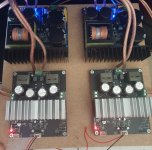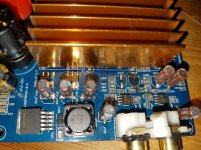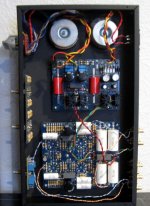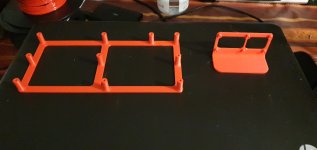Just an update regarding my earlier problem using a TPS7A4700 regulator to power the amps's 12V rail -
tests revealed the regulator to be faulty, and the supplier offered a replacement reg board at no cost - thanks to Alex at ldovr.
But since the replacement involved de-soldering the bad reg from the rectifier main board, I decided to change the regulator to LT3045, which ldovr also provide.
All working great now.
Some brief listening tests last night gave a hint that I could hear some micro-detail which I couldn't hear before, but with all the fault-finding and delays involved, I haven't done a same-day comparison, and really can't say for sure.
So the jury is out about whether using an external reg for the 12V rail achieves a benefit ...
I'm just happy that my amp is working and I'm enjoying my tunes.
Oh, but bypassing the SE-to-differential input stage certainly does have a big effect.
Hi,
I have the 1 channel version of the 3eauduo amp board.
Can you share more information about your bypassing method, the caps you add on the xlr plugs, and the benefits?
I'm actually using the board with single end signal (rca from an smsl a8) and I feel lack of bass, and some harsh in the high band.
I have 2 very good 600w power supply.its on Eval board at the moment 🤣
Thanks
Attachments
Hi all. I've been following this thread for over a year now because I'm impressed with this this amplifier even though I have the generic Chinese version. Today I started upgrading the the capacitors to Nichicon and Elna's. I'm not electronic savy or have much skill in soldering but I want to give myself the chance to learn after reading here the improvements you've all made to this amplifier. After successfully fixing 8 of the 10 I was replacing number 9 didn't work. Both solder pads came off as well as some trace. I'll try uploading a picture. if anyone here can advise me if it's salvageable or am I wasting my time on this I'd be very appreciative.
Attachments
Hi all. I've been following this thread for over a year now because I'm impressed with this this amplifier even though I have the generic Chinese version. Today I started upgrading the the capacitors to Nichicon and Elna's. I'm not electronic savy or have much skill in soldering but I want to give myself the chance to learn after reading here the improvements you've all made to this amplifier. After successfully fixing 8 of the 10 I was replacing number 9 didn't work. Both solder pads came off as well as some trace. I'll try uploading a picture. if anyone here can advise me if it's salvageable or am I wasting my time on this I'd be very appreciative.
I use 10uh and 1uf in old version,
In new version 7uh and 0,68 uf
Frequency 600kHz
Hi,
Which 3e amp board are you using? I have the mono pbtl one, with 10uH a 1uF and was thinking in modifying them as i'm using 6ohms speakers. but the TI manual is not very clear on that point (to me)
Do you feel any difference between yhe 10 and 7uH ?
Thanks
I'm sure you realise, but let me reiterate, once the opamps are bypassed you lose SE-to-differential conversion to the TPA3255 inputs, so obviously the source must then be differential. Your SMSL A8 cannot be used.Can you share more information about your bypassing method, the caps you add on the xlr plugs, and the benefits?
...
I'm actually using the board with single end signal (rca from an smsl a8)
Regarding my input caps - nothing special - ELNA SILMIC II 10uF 50V. I could have used the original onboard caps, but when I first did the modification I completely removed the onboard caps, intending to go cap-less (my DAC's output has no DC offset). Later I decided to add outboard caps so I could experiment with other (balanced) source devices.
Regarding method:
First disable the opamps by cutting the leg of the power supply pin - pin 8.
On your TPA3255 mono board, the 2 caps between the opamp and heatsink are the blocking caps.
i) you can completely removed these caps, then connect your +ve and -ve input wires to the newly-exposed pads where the negative side of the capacitors were attached. Now wire some outboard blocking caps.
or ii) lift only the positive side of each of the 2 caps, and connect your +ve and -ve input wires to the positive pins of these caps.
Bypassing the opamps won't get you any more bass, but it may certainly remove or reduce that harshness you describe. Read my impressions here -I feel lack of bass, and some harsh in the high band.
https://www.diyaudio.com/forums/class-d/287470-tpa3255-diy-discussion-design-etc-177.html#post6087528
Waouuu! Thank you for this perfect answer, very clear redarding the bypass.
One point, where do you connect the 3rd xlr cable(neutral)?
Also, regarding the DAC, I'm hesitating between the new dual 9038q2m raspberry from audiophonics ( AUDIOPHONICS EVO-SABRE DAC Symetrique 2x ES9038Q2M USB RPI SPDIF BT / XLR RCA - Audiophonics) or a topping like d70 BT or Dx7pro. But I don't know about the DC offset you mentioned. How to check this?
Also, lots of people are using a tube preamp on unbalanced port and seems to be very happy with it ( FX-AUDIO TUBE-03 Preamplificateur a Tubes 6J1 Stereo Noir - Audiophonics)
One point, where do you connect the 3rd xlr cable(neutral)?
Also, regarding the DAC, I'm hesitating between the new dual 9038q2m raspberry from audiophonics ( AUDIOPHONICS EVO-SABRE DAC Symetrique 2x ES9038Q2M USB RPI SPDIF BT / XLR RCA - Audiophonics) or a topping like d70 BT or Dx7pro. But I don't know about the DC offset you mentioned. How to check this?
Also, lots of people are using a tube preamp on unbalanced port and seems to be very happy with it ( FX-AUDIO TUBE-03 Preamplificateur a Tubes 6J1 Stereo Noir - Audiophonics)
Last edited:
The 3rd XLR cable is ground, not neutral. It connects to a GND connection on the amp board - where your black wire is presently connected would be fine.where do you connect the 3rd xlr cable(neutral)
XLR pin 2 = +ve
XLR pin 3 = -ve
XLR pin 1 = AGND
95% of DAC output stages are opamp-based, and will have some DC offset. Assume yours does, and use a blocking cap.I don't know about the DC offset you mentioned.
Yes I know - I've tried that preamp, myself. My results are complicated, but in short; the TPA325x and TPA311x amplifiers are certainly detailed, but I feel they have just a little too much "sizzle", and more so when in combination with an opamp-based preamp or linestage. That's why the TUBE-01 is so popular in my opinion - it dials down the sizzle!lots of people are using a tube preamp on unbalanced port and seems to be very happy with it
Unfortunately it's not a great match with the TPA325x amps - because the TUBE-01 is single-ended, and the TPA325x needs SE-to-diff conversion circuitry - so you end up with tubes + opamps.
A potentially better match for TPA325x amps would be a tube-based SE-to-diff front end, such as the GlassWare Balancer -
Balancer
Or maybe a jfet-based SE-to-diff front end.
Thanks drMordor. I assume that I would expose the trace and solder the ridged wire to it, am I correct in this?Kurtsmiling no problem, use a thin rigid wire for the connection
The 3rd XLR cable is ground, not neutral. It connects to a GND connection on the amp board - where your black wire is presently connected would be fine.
XLR pin 2 = +ve
XLR pin 3 = -ve
XLR pin 1 = AGND
95% of DAC output stages are opamp-based, and will have some DC offset. Assume yours does, and use a blocking cap.
Yes I know - I've tried that preamp, myself. My results are complicated, but in short; the TPA325x and TPA311x amplifiers are certainly detailed, but I feel they have just a little too much "sizzle", and more so when in combination with an opamp-based preamp or linestage. That's why the TUBE-01 is so popular in my opinion - it dials down the sizzle!
Unfortunately it's not a great match with the TPA325x amps - because the TUBE-01 is single-ended, and the TPA325x needs SE-to-diff conversion circuitry - so you end up with tubes + opamps.
A potentially better match for TPA325x amps would be a tube-based SE-to-diff front end, such as the GlassWare Balancer -
Balancer
Or maybe a jfet-based SE-to-diff front end.
Yhanks again !
So,I just bought... lots of things
A potentially better match for TPA325x amps would be a tube-based SE-to-diff front end, such as the GlassWare Balancer -
Balancer
-->> this looks great ! As Im designing/building a "one box" will all the staff inside (amplifier, dac, power suplies raspeberry pi screen etc, it would be nice to know if I'm adding tubes as well
Well if you actually do assemble a 3e-audio amp + GlassWare balancer front end, I think that could be a killer amplifier! But of course such a configuration is only necessary for single-ended sources ...
in your case you will soon have a balanced DAC - so you don't need SE-to-diff conversion at all. This allows you to bypass the 3e-audio's opamps, then the only opamps in your signal chain will be those of the output stage of your Audiophonics DAC. And I think this could be a damn fine sounding audio system!
Let me clarify my standpoint: I don't have a issue with opamps in general. But I do think it's a bad idea to have more opamps in the signal chain than is absolutely necessary.
in your case you will soon have a balanced DAC - so you don't need SE-to-diff conversion at all. This allows you to bypass the 3e-audio's opamps, then the only opamps in your signal chain will be those of the output stage of your Audiophonics DAC. And I think this could be a damn fine sounding audio system!
Let me clarify my standpoint: I don't have a issue with opamps in general. But I do think it's a bad idea to have more opamps in the signal chain than is absolutely necessary.
I do completely agree, more simple the signal way the better ! but maybe those "tubes things" add "natural" over the electronic path... I really don't know as this is my first Class D amp project ! I have add the confirmation by audiophonics that the output of the DAC are driven by opamps. -> so blocking caps needed right ? the one I bought are selna II 10uF but 35V, not 50 as theu dont have in audiophonics. Is that ok ?
Thanks again, I'm so excited to get my order

 like a kid
like a kid 
Thanks again, I'm so excited to get my order
Hi All,
I kind of new here and for sure new to Class D amps. If this is the wrong place to post this I'm sure you will let me know. I built up an amp using T.I.s EVM3255 board and a Meanwell 48 SMPS. I do not have access to any fancy audio measurement equip just a voltmeter and a scope. I see about 520mV RMS at 450 KHz. at the output loaded with 4 ohms. Does this sound correct?
I kind of new here and for sure new to Class D amps. If this is the wrong place to post this I'm sure you will let me know. I built up an amp using T.I.s EVM3255 board and a Meanwell 48 SMPS. I do not have access to any fancy audio measurement equip just a voltmeter and a scope. I see about 520mV RMS at 450 KHz. at the output loaded with 4 ohms. Does this sound correct?
A potentially better match for TPA325x amps would be a tube-based SE-to-diff front end, such as the GlassWare Balancer
It's great that you might consider the GlassWare Balancer, but I recommend against installing it in the same case as the TPA3255 modules. The Balancer is a large (and expensive) kit, which really deserves its own chassis. This will also provide flexibility for the future, if you discover some new differential amplifier to match it with.-->> this looks great ! As I'm designing/building a "one box" with all the stuff inside (amplifier, dac, power supplies, raspberry pi, screen etc) it would be nice to know if I'm adding tubes as well
Attachments
Effectively it looks huge...
I should receive my DAC today, and have been working on the crossovers of my speakers 👍
Will test this first 😂
I don't know if it's psychological, but something I have always laugh about, the electronic burn in, seems to really happen. I have now a lot more bases and definition in my sou d than at the beginning... I mean I had to set the bass at the maximum at the beginning to get a bit of them, now I'm back at the setting 0 position and I have a lot more...
Anyway, looking forward to install all the new staff this afternoon. I have already design/print the support 🤣
Will let you know.
I should receive my DAC today, and have been working on the crossovers of my speakers 👍
Will test this first 😂
I don't know if it's psychological, but something I have always laugh about, the electronic burn in, seems to really happen. I have now a lot more bases and definition in my sou d than at the beginning... I mean I had to set the bass at the maximum at the beginning to get a bit of them, now I'm back at the setting 0 position and I have a lot more...
Anyway, looking forward to install all the new staff this afternoon. I have already design/print the support 🤣
Will let you know.
Attachments
@ Linuxfan :
Are you familiar with all the RPi things? I'm starting to check which solutions are available to get a good connected solution (audio, with rouch screen, and a remote control able to manage the entire system) but it looks to not be very simple to have it working properly ��
Are you familiar with all the RPi things? I'm starting to check which solutions are available to get a good connected solution (audio, with rouch screen, and a remote control able to manage the entire system) but it looks to not be very simple to have it working properly ��
- Home
- Amplifiers
- Class D
- What is wrong with TPA3255?



